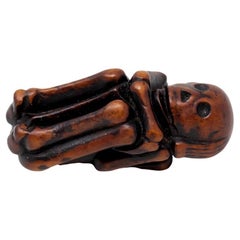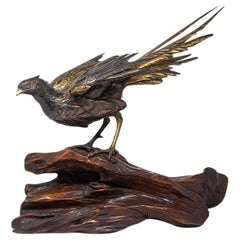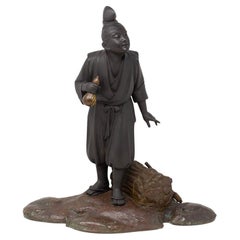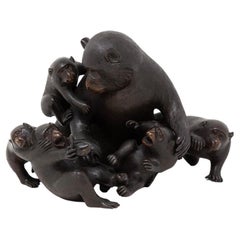Want more images or videos?
Request additional images or videos from the seller
1 of 17
German Memento Mori Carved Skull
Price:$2,800
$4,549.42List Price
About the Item
- Dimensions:Height: 4.33 in (11 cm)Width: 3.07 in (7.8 cm)Depth: 3.66 in (9.3 cm)
- Style:Gothic (In the Style Of)
- Materials and Techniques:
- Place of Origin:
- Period:
- Date of Manufacture:18th Century
- Condition:Wear consistent with age and use.
- Seller Location:Newark, GB
- Reference Number:Seller: SBDDD1stDibs: LU6971229226752
About the Seller
5.0
Gold Seller
Premium sellers maintaining a 4.3+ rating and 24-hour response times
Established in 2019
1stDibs seller since 2022
39 sales on 1stDibs
Typical response time: 2 hours
Authenticity Guarantee
In the unlikely event there’s an issue with an item’s authenticity, contact us within 1 year for a full refund. DetailsMoney-Back Guarantee
If your item is not as described, is damaged in transit, or does not arrive, contact us within 7 days for a full refund. Details24-Hour Cancellation
You have a 24-hour grace period in which to reconsider your purchase, with no questions asked.Vetted Professional Sellers
Our world-class sellers must adhere to strict standards for service and quality, maintaining the integrity of our listings.Price-Match Guarantee
If you find that a seller listed the same item for a lower price elsewhere, we’ll match it.Trusted Global Delivery
Our best-in-class carrier network provides specialized shipping options worldwide, including custom delivery.You May Also Like
Hand Carved Wood Memento Mori Skull Cane Walking Stick Handle
Located in Studio City, CA
A fantastic and wonderfully hand carved piece. This smiling, mischievous skull is carved in very fine detail. Would be the crown jewel of any walking stick collection once attached t...
Category
20th Century Sculptures and Carvings
Materials
Wood
Memento mori sculpture depicting a skull, Italy 1700.
Located in Milan, IT
Wunderkammer Memento Mori sculpture. depicting a skull, carved from a single piece of fruitwood, this sculpture depicts a skull with deliberately exaggerated and distorted proportion...
Category
Antique Early 18th Century Italian Figurative Sculptures
Materials
Wood
An Unusual and Rare English ‘Memento Mori’ Carved Shrine with Two Human Skulls
Located in London, GB
An Unusual and Rare English ‘Memento Mori’ Carved Shrine with Two Human Skulls to the underside, a carved ‘Dragonfly’
Marble
16th / 17th Century
England
Size: 36cm high, 28cm w...
Category
Antique 16th Century English Figurative Sculptures
Materials
Marble
$22,500
H 14.25 in W 11 in D 4 in
Antique Painted Memento Mori Skull, Dated 1769 Birth Year of Napoleon I
Located in Doha, QA
A truly extraordinary and evocative object: an 18th century hand-carved wooden skull, richly hand-painted and inscribed with the date 1769. This rare Memento Mori was created as a me...
Category
Antique 18th Century French Baroque Figurative Sculptures
Materials
Wood, Paint
$8,750
Free Shipping
H 5.52 in W 5.52 in D 6.3 in
Memento Mori Composition of Two Wooden Skulls, a Stag beetle and a Red Coral Bra
Located in Leuven , BE
The skull is composed out of light brown wood, with a metallic beetle holding a smaller replica of the wooden skull between its two front legs. On the top...
Category
21st Century and Contemporary Belgian Figurative Sculptures
Materials
Organic Material
$1,493
H 16.15 in Dm 7.49 in
Memento Mori Late 17th Century Faux White Marble Child Skull Figure Sculpture
Located in Brescia, IT
This engaging sculpture of Memento Mori dated Late 17th Century, is part of a production of small terracotta figures for private use, which Giuseppe Maria Mazza, created throughout h...
Category
Antique Late 17th Century Italian Baroque Figurative Sculptures
Materials
Terracotta, Giltwood
$48,167
H 16.54 in W 20.08 in D 10.24 in
Carved Sandstone Jain Family Group, 6th-7th Century, Uttar Pradesh, India
Located in Austin, TX
A fine and rare Indian carved sandstone stele of a Jain family group, Sarnath style, early Indian Medieval period, 6th-7th century, Uttar Pradesh, India.
Carved from a single block of buff sandstone, the stele features a Jain family group comprised of a father, mother, and two children. The family group is portrayed upon a lotus pedestal under a tall palm tree. The mother and father both seated in a relaxed pose known as lalitasana, or royal ease pose, a jovial expression on their faces. The mother holds the daughter in her lap. The younger son scampers mischievously up the trunk of the palm tree, his head turned to look back at his parents.
Above the family, nestled in a niche amongst the palm fronds, an image of a Jain Tirthankara...
Category
Antique 15th Century and Earlier Indian Medieval Sculptures and Carvings
Materials
Sandstone
$17,500
H 10.25 in W 8 in D 4 in
Indian Carved Sandstone Frieze of Lakshmi, Central India, 10th-11th Century
Located in Austin, TX
A large and impressive Indian carved sandstone architectural frieze featuring a central image of the Hindu goddess Lakshmi flanked by two atten...
Category
Antique 15th Century and Earlier Indian Medieval Sculptures and Carvings
Materials
Sandstone
$37,500
H 18.75 in W 30 in D 9 in
Antique Hand Carved Panel
Located in New York, NY
Antique hand carved architectural panel from Toraja. This carving symbolizes the protection of the home. Originally used as an exterior panel. Great art piece.
This antique panel ...
Category
Antique Early 1900s Primitive Abstract Sculptures
Materials
Wood, Reclaimed Wood
Antique Hand Carved Panel
Located in New York, NY
Antique hand carved architectural panel from Toraja. This carving symbolizes the protection of the home. Originally used as an exterior panel. Grea...
Category
Antique Early 1900s Primitive Abstract Sculptures
Materials
Wood, Reclaimed Wood
More From This Seller
View AllJapanese Edo Period (1603-1868) Skeleton Foetus Netsuke
Located in Newark, England
Laying Foetus
From our Japanese collection, we are pleased to offer this Japanese Edo Period Skeleton Netsuke. The Skeleton Netsuke is carved from Boxwood depicting a skeleton in t...
Category
Antique Mid-19th Century Japanese Edo Sculptures and Carvings
Materials
Wood, Boxwood
Japanese Bronze Pheasant Okimono Genryusai Seiya
Located in Newark, England
Unusual Casting of a Pheasant in Flight
From our Japanese collection, we are delighted to offer this Japanese bronze okimono of a Pheasant upon a naturalistic root wood base. The Ph...
Category
Antique Late 19th Century Japanese Meiji Sculptures and Carvings
Materials
Bronze
Japanese Bronze Okimono Sculpture by Yamamoto Kozan
Located in Newark, England
YOUNG MAN WOOD CUTTING
From our Japanese collection, we are pleased to offer this Japanese Bronze Okimono by Yamamoto Kozan. The Japanese Bronze Sculpture cast in Bronze with a natu...
Category
Early 20th Century Japanese Meiji Sculptures and Carvings
Materials
Bronze
Japanese Meiji Period Bronze Monkey Group Sculpture Okimono Shosai
Located in Newark, England
Featuring Seven Japanese Macaques
Form our Japanese collection, we are delighted to offer this Japanese Bronze Monkey Group by Shosai. The Japanese Bronze Group displaying a male father monkey and his infants playing around and being mischievous with Persimmon fruit. The monkeys modelled as Japanese macaque monkeys (snow monkey). The bronze okimono is beautifully patinated with a highly lifelike and naturalistic casting signed to the underside Shosai 正齊鋳. The Bronze group dates to the Meiji Period (1868-1912) circa 1885.
Japanese macaque (snow monkey) is a terrestrial Old World monkey species that is native to Japan. They are known as snow monkeys because some live in areas where snow covers the ground for long periods each year hence their nickname. No other non-human primate lives further north or in a colder climate than the snow monkey. Individuals have brownish grey fur, pinkish-red faces, and short tails. Two subspecies are known and their conservation Status is of least concern. In Japan, the species is known as Nihonzaru ニホンザル, 日本 (Japan/Nihon) and saru 猿 (monkey) to distinguish it from other primates, but the Japanese macaque is the only species of monkey in Japan.
The Japanese macaque features heavily in the religion, folklore, and art of Japan, as well as in proverbs and idiomatic expressions in the Japanese language. They are often seen in paintings, block prints and represented in all manner of carvings from Okimono to netsuke. Many of these art forms reside in the world’s most famous museums and collections, some of the most prominent pieces by artists such as Mori Sosen and Kawanabe Kyosai. In Shinto belief (Japan’s indigenous religion/nature religion) legendary mythical beasts known as raiju sometimes appeared as monkeys and kept Raijin (the god of lightning/storms) company. In another well known tale the three wise monkeys who warn people to “see no evil, hear no evil and speak no evil” can be seen depicted in relief over the door of the famous Tosho-gu shrine in Nikko.
Meiji Period was an era of Japanese history that spanned from 1868 to 1912. It was the first half of the Empire of Japan, when the Japanese people began to build a paradigm of a modern, industrialised nation state and emergent great power, influenced by Western countries and aesthetics. As a result of radically different ideas, the changes to Japan were profound and it affected the social structure, politics, economy, military, and foreign relations across the board. The period corresponded to the reign of Emperor Meiji and was preceded by the Keio era and was succeeded by the Taisho era.
Cultural Art during the Meiji Period was of particular interest to the government and they overhauled the art export market which in turn promoted Japanese arts via various world’s fairs, beginning in Vienna at the world fair in 1873. The government heavily funded the fairs and took an active role organising how Japan’s culture was presented to the world including creating a semi-public company named Kiritsu Kosho Kaisha (First Industrial Manufacturing Company). The Kiritsu Kosho Kaisha was used to promote and commercialise exports of Japanese art and established the Hakurankai Jimukyoku (Exhibition Bureau) to maintain quality standards. For the 1876 Centennial International Exhibition in Philadelphia, the Japanese government created a Centennial Office and sent a special envoy to secure space for the 30,000 items that would be displayed. The Imperial Household also took an active interest in arts and crafts, commissioning works by select artists to be given as gifts for foreign dignitaries further emphasising the high quality and importance of Japanese art. Just before the end of the 19th century in 1890, the Teishitsu Gigeiin (Artist to the Imperial Household) system was created to recognise distinguished artists. These artists were selected for their exceptionally high quality wares and talent in their own industry. Over a period of 54 years Seventy artists were appointed, amongst these were ceramicist Makuzu Kozan and cloisonné enamel artist...
Category
Antique Late 19th Century Japanese Meiji Sculptures and Carvings
Materials
Bronze
African Carved Camel Sculpture
Located in Newark, England
From our Decorative collection, we are pleased to offer this finely carved African Camel Sculpture.
The camel is carved from dense camel thorn wood, a material valued for its durabi...
Category
Antique Late 19th Century African High Victorian Animal Sculptures
Materials
Wood
Antique German Bronze Figure by Hermann Gladenbeck
Located in Newark, England
GIRL WITH GOSLINGS
From our Antique Bronze Sculptures collection, we are delighted to offer this German Bronze Figure by Hermann Gladenbeck. The Bronze beautifully cast with a dark...
Category
Antique Early 1900s German Art Nouveau Figurative Sculptures
Materials
Bronze



